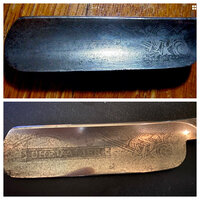So I know this has been talked about before, and that a lot of people say it’s not really feasible, but I have found a way to start “bringing back” the etchings on a blade. I’m going to continue to work on it. I’ll post this comparison which I know I’m gonna get flamed on for having one picture with the flash and one without, but I didn’t take the first picture and I only thought to take a picture after it worked. So I had to use the pic that was from where I bought it. Trust me though, it does work. I believe I’ll have to do multiple passes and take care not to destroy the blade since I’m using a metallurgic reagent and it’s really quite dangerous. But here are the first pass comparisons. I’m still learning how to make it work better. But it’s pretty awesome to see it happen.
You are using an out of date browser. It may not display this or other websites correctly.
You should upgrade or use an alternative browser.
You should upgrade or use an alternative browser.
Restoring etching!
- Thread starter Mikesmustache
- Start date
No gentlemen on this forum will “flame” you, but it would be nice if you can share more information on the full process you are using. You might actually get some guidance from folk with skills in this field.
If possible it can be a game changer for those restoring razor such as myself.
If possible it can be a game changer for those restoring razor such as myself.
- Thread starter
- #3
I want to do a few more passes to see how much I can revive the etching to make it worth it. It’s extremely dangerous to make the reagent if you don’t take the right precautions. I’m not trying to keep it a secret for profit or anything, I just don’t want someone getting hurt because they want to try it out. I’m using an acid to darken the etchings. I’m not sure exactly how it works because I didn’t design the formula. I just repurposed it.
Lots of people acid etch at home. As long as proper precautions are taken it is no more dangerous than mowing the lawn IMO. I have hydrochloric acid, sulfuric acid and phosphoric acid (and plenty of others) on hand at all times. Very useful for different tasks around the workshop.
It's too bad you didn't get a "before" pic with the same lighting, but no one here will flame you for it.
It's too bad you didn't get a "before" pic with the same lighting, but no one here will flame you for it.
- Thread starter
- #5
Hah yeah I’m beating myself up for that. I am going to strip it and start over soon because I’m learning how to use this properly. I feel comfortable posting the link and what concentrations I used, I just want people that don’t understand how to mix chemicals to be really wary of the process. This reagent is deadly if not mixed properly. Like even mixing it properly is super sketchy. I had to get my old chemistry professor involved just to cover anything I wasn’t aware of.
Are you making your own ferric chloride? That's about the simplest way to darken regular carbon steel. Sounds more like Fry's reagent however by your description.
- Thread starter
- #7
It is Fry’s reagent. Im using a higher concentration of Ammonium Chloride and Hydrochloric Acid than I think most people would get readily. But I didn’t have trouble getting it. Anyways I use Fry’s to draw the copper into the etch and then I’m trying to decide if I want to electro etch or just make some a hydrochloric acid/hydrogen peroxide mix and re etch it.
If you can, purchase a good stencil. They can be made from a good photograph of the logo. Electro-etching works very well, but having a pitted surface to begin with may make getting sharp edges difficult. Keep us updated with your results, I'm sure many are interested.
Similar threads
- Replies
- 48
- Views
- 2K
- Replies
- 28
- Views
- 905
- Replies
- 7
- Views
- 768
- Replies
- 6
- Views
- 1K
- Replies
- 15
- Views
- 2K
